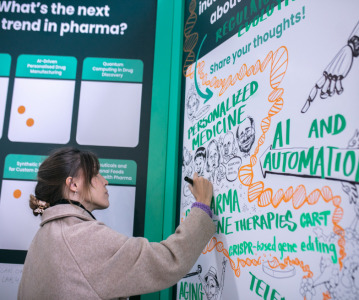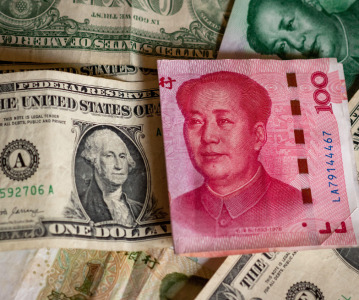Interview: Indian healthcare reform offers thriving pharmaceutical market opportunities

Global Pharma Insights speaks to Deepak Sapra, CEO of Active Pharmaceutical Ingredients and Services at Dr. Reddy's Laboratories, for his perspective on the current state of the Indian healthcare and pharmaceuticals sector
The Indian pharmaceutical sector is enjoying a tremendous growth trajectory as the government seeks to improve healthcare access for its burgeoning population while also reducing supply chain dependency on other countries.
Global Pharma Insights spoke to Deepak Sapra (below), CEO of Active Pharmaceutical Ingredients and Services at Dr. Reddy's Laboratories for his perspective on the current state of the Indian healthcare and pharmaceuticals sector and how it is providing opportunities for both domestic and multinational drugmakers and healthcare providers despite the challenges of the ongoing coronavirus pandemic.

One of the most fascinating things about the Indian pharmaceutical market is just how huge and fragmented it is. There are literally thousands of enterprises operating in the sector. I presume this means it is fertile ground for an SME to flourish and potentially become a large multinational player?
There is certainly a lot going on in the Indian market and significant opportunities exist in two dimensions: firstly, India for India and secondly, India for the rest of the world. There are a lot of activities being undertaken by both Indian and non-Indian companies with regards to addressing the Indian market and leveraging the capabilities that the Indian pharmaceutical industry has for the rest of the world.
Starting from the patient side, India has a population of almost 1.4 billion people, out of which, a very large number still does not have access to good quality healthcare. Around 50-60% will have some sort of access to healthcare but the balance doesn’t have any access to healthcare as we know it. As a result, there is very large headroom for growth in terms of enhancement of access, in terms of more patients consuming medication and accessing both preventive and curative healthcare.
Another very important point is that although the amount paid per capita for healthcare in India is among the lowest in the world, the rate of growth is very high, leading to an enhancement of demand. With a growing middle-class population in different parts of the country and overall economic levels increasing in multiple population sub-segments, spend on healthcare is much more than it used to be.
Also, Indians are starting to access healthcare in a more comprehensive manner – they’re not just looking at therapeutic and curative options but also preventive options such as vaccines and nutritional products. All these increases the per capita spend on healthcare.
Irrespective of the current coronavirus situation, I expect the overall demand side of the Indian pharmaceutical market to increase at a very meaningful rate.
What is the Indian government doing in terms of introducing and facilitating access to healthcare for that large proportion of the population who do not yet have it?
There are several important reforms that have taken place in the last couple of years. One significant ongoing government initiative is the introduction of universal healthcare coverage called Ayushman Bharat. It’s a national insurance programme that provides secondary healthcare to those who require specialist treatment and also tertiary healthcare for those requiring hospitalisation. As of now, around 400-500 million Indians are eligible for the scheme and so far, around 100 million have enrolled.
A second government initiative is the creation of promotion of generic medicines throughout the country. It is promoting non-branded medication being made available at a significant discount to their branded equivalents and has set up some dedicated pharmacies for this. India is of course a very large country and different states are at different stages of implementation. Those states that have made the most progress are seeing significant offtake in these pharmacies and that is enabling better access to healthcare.
The third scheme has implications for the pharma industry and will ultimately have implications for patients as well: the government is trying to make the Indian pharmaceutical supply chain less dependent on other countries and more self-sufficient in terms of the entire value chain being manufactured within the country. As an example, India manufactures many formulations and APIs but several components of these come in from outside the country and there is a large dependence on non-Indian sources. There are varying estimates of how many drugs where the supply chain is dependent on suppliers outside India ranging from 60-80%. The government is trying to encourage local production for the key products, where there is a critical need for a larger part of the population. It proposed a set of schemes and incentives to encourage the existing Indian industry to backward-integrate more and have a greater control over the supply chain.
Finally, from the standpoint of India being a pharmacy to the world and playing an important role in global medicines supply, a lot of companies in India are setting up their manufacturing and R&D facilities in line with the requirements of several regulatory bodies around the world. India today has the largest number of US Food and Drug Administration-approved facilities outside the US and a very large proportion of the medicines supplied in countries like the US come from India. Around 40% of US-prescribed generics originate from India. That means that the process, quality and regulatory aspects must be aligned with what’s required in these countries and therefore we’re seeing much higher involvement and interest by some of these national regulatory bodies in what’s happening in India. The FDA now has a significant local presence in India and has regular interactions with the Indian manufacturing industry.
The Indian government is planning to set up API manufacturing parks in states like Himachal Pradesh, Telangana, Andhra Pradesh and Assam. India imported APIs worth $2.5 billion in 2018-19 from China. These imports were crucial to fuelling both domestic products and exports. Will these parks help to reduce India’s dependency on imports from China?
If I had to answer in one word, I would say ‘yes’ but a lot of things must fall in place for that to happen. We need to remember that this is a plan on paper currently and execution is a different ballgame. Broadly the plan is to create these pharmaceutical parks which will be located at relevant locations. These parks would be self-sufficient in the sense that they would make pharmaceutical products, APIs and also the intermediates and key starting materials – that is a key objective.
A second objective is to create an entire ecosystem of healthcare and I was involved in some of the provisioning activities for some of the pharma parks for key states. Everywhere there are two or three themes that stand out. Firstly, create a park that is an answer to major global pharmaceutical issues; this will not only include manufacturing but also R&D hubs which would bring in capabilities on certain upcoming technologies. Within the park, there would also potentially be large universities which would train the workforce on pharmaceuticals and chemistry and also potentially a place for everyone who works or studies there to stay. That’s the vision that the chief ministers of the states are talking about.
Another objective is around digital technology; India has been very strong on IT for the last two decades and the question is how we create the right intersection of life sciences and IT and have collaboration with top institutions on digital initiatives on healthcare.
On paper, these plans look great and I would expect that in the next 9-12 months, these plans will develop into clear projects and a clear set of deliverables on which to execute.
India has a lot to learn in terms of efficient and effective execution of projects, whether it’s timelines, or sticking to the original costs. Those are areas we need to pay particular attention to when executing to ensure the vision for these large initiatives is fulfilled.
Obviously generics comprises a huge part of Dr. Reddy’s business portfolio. Is India still a good market to sell generics? Despite the legislation supporting generics use, surely there are certain market pressures companies have to contend with?
The three fundamental pillars of the generics industry are speed, cost and quality and what India has done over the past twenty years is build very strong capabilities in each of these three areas. Those are things that stand it in good stead as India looks to expand worldwide.
When I say speed, I mean speed to market, being the first to market, coming up with the product much before it is likely to go generic and aligning the R&D and manufacturing capabilities to be aligned with the different regulatory requirements around the world. Taking the US market as an example, one of the key milestones for the generics industry is to be hitting the ‘NCE minus one’ date, meaning you actually have to be ready with the product several years before it is commercialised. So typically, 8-10 years before patent expiry, you have to start developing the API and doing the formulation and get all this ready so it can be filed with the FDA or the European authorities as soon as the expiry of the data exclusivity period allows you to. I still think India has a very strong competitive advantage on speed over most other countries in the world and that is really helping it to be a prominent player in the generics industry no matter which market you look at.
Quality has been an important and highly discussed subject when it comes to Indian pharmaceuticals. As we’ve already mentioned, there are a large number of players in the country and all kinds of markets and customer segments that they cater for. With regard to the Indian companies who are looking at markets such as the US, Europe and Japan where the regulatory requirements are high, there has been a tremendous amount of upscaling in the quality and regulatory processes and in the way systems have been streamlined and automation has been done. Before the year 2015, quite a few companies had a challenging time meeting regulatory requirements but a lot of enhancements in processes and systems has happened since then which makes me very confident about the ability of Indian companies to be up to speed and in line with expectations. In addition, I think the pharma industry is also prepared that these expectations are not static and that they have to keep on being aligned to meet them.
When it comes to cost, full integration between the formulation and the API is crucial. We’re also beginning to pay a lot of attention to going backward from the API to the intermediates and the key starting materials. It’s a long journey but there is a clear path forward and if we execute it right we should be in a position to backward-integrate and de-risk the supply chain on APIs as well.
Irrespective of what happens in other parts of the world, as long as India continues to leverage and play on these strengths, it will continue to remain a key player in the worldwide generics industry.
The global pandemic has sent shockwaves around the globe, and it seems that every day we’re learning something new and situations can rapidly change. Has COVID-19 taught us any lessons about the Indian pharmaceutical sector and its response to the crisis?
Personally, I feel very proud of the way Indian pharma has risen to the occasion in this pandemic. Today, if you look at the medical solutions for COVID-19, whether they are on the therapeutic side or they are on the preventive side, India has a very important role to play.
A lot of the therapeutic and potentially therapeutic drugs that have been tested and used to fight this pandemic so far – for example, hydroxychloroquine, dexamethasone, remdesivir, favipiravir, a lot of the antiviral agents and anti-inflammatory agents – have been manufactured in India. In addition, many countries around the world are taking medication that is manufactured in India, either formulations or APIs. If you look at the clinical trials for drugs that are still not being used but could be of potential use in this pandemic, India probably comes out as one of the top countries where these efforts are underway.
I think that India’s contribution to addressing this pandemic from a medicine supply and availability standpoint has been immense.
If you look at the preventive side and vaccines, there are many efforts going on around the world and there are several tie-ups Indian manufacturers have with various ongoing international programmes. Tomorrow, if a vaccine does get approved, it will still need to be manufactured to be available for the world’s population of 7.8 billion people. A very large proportion of that we expect to be produced in India. Today, I think almost one third of global vaccines are made in Hyderabad, the city where I am currently, and around 50% in India.
Another area where India is involved is the testing for the virus. We see a lot of activities in regard to the development of testing kits such as RT-PCR (real-time reverse transcription polymerase chain reaction) tests which a number of biotech and diagnostic companies are currently in the process of executing here in India. So from a pandemic standpoint, we’re by no means out of it and have a long way to go but whatever the solutions turn out to be, I feel India will play a very significant part.

Related News
-
News Lessons from CPHI Milan 2024: Sunny Intervals for Pharma Manufacturing?
As the 2024 CPHI conference wrapped up in Milan, we caught up with L.E.K. Consulting – a global strategy consulting firm with deep expertise in pharma manufacturing – to discuss evolving market perspectives and business outlook. -
News US BIOSECURE Act passed by US House of Representatives
The controversial act, which has already impacted several foreign companies operating in the US, was passed by the House of Representatives on September 9, 2024. It is now headed for the US Senate before it can be signed into law by President Joe Biden... -
News Pharma Supply Chain People Moves
The latest appointments, promotions, and structural changes across the pharmaceutical supply chain. -
News Drug prices agreed upon as part of the US Inflation Reduction Act
The Inflation Reduction Act brought into constitution by the Biden administation in 2022, which proposed a drug price negotiation between the government and pharmaceutical companies, has reached it's first agreement. -
News BIOSECURE Act continues to loom over Chinese pharma manufacturers
With the US BIOSECURE Act on its way to passing into legislation, Chinese companies are facing declining revenues within the first half of 2024 as US pharmaceutical and healthcare companies pull their businesses from the country. -
News Ophthalmologic drug product Eylea faces biosimilar threats after FDA approvals
Regeneron Pharmaceutical’s blockbuster ophthalmology drug Eylea is facing biosimilar competition as the US FDA approves Biocon’s Yesafili and Samsung Bioepis/Biogen’s Opuviz. -
News ONO Pharmaceutical expands oncology portfolio with acquisition of Deciphera
ONO Pharmaceutical, out of Japan, is in the process of acquiring cancer-therapy maker Deciphera Pharmaceuticals for US$2.4 billion. -
News First offers for pharma from Medicare drug price negotiations
Ten high-cost drugs from various pharma manufacturers are in pricing negotiations in a first-ever for the US Medicare program. President Biden’s administration stated they have responded to the first round of offers.
Position your company at the heart of the global Pharma industry with a CPHI Online membership
-
Your products and solutions visible to thousands of visitors within the largest Pharma marketplace
-
Generate high-quality, engaged leads for your business, all year round
-
Promote your business as the industry’s thought-leader by hosting your reports, brochures and videos within your profile
-
Your company’s profile boosted at all participating CPHI events
-
An easy-to-use platform with a detailed dashboard showing your leads and performance




.png)
.png)

.png)